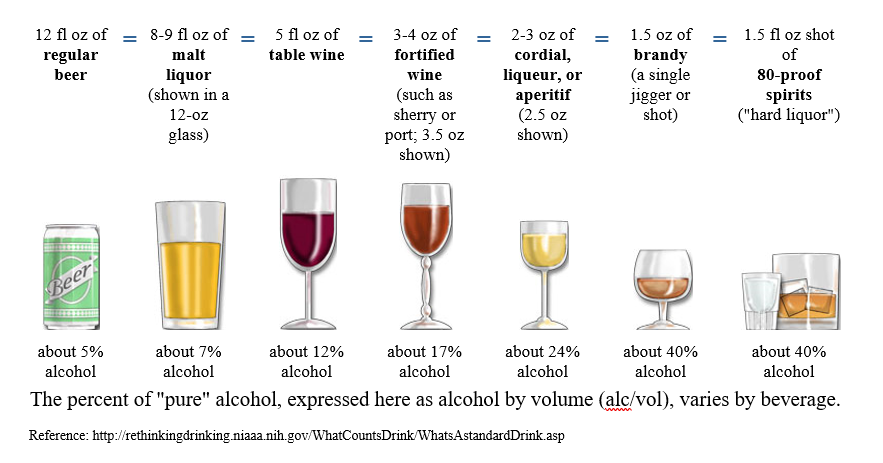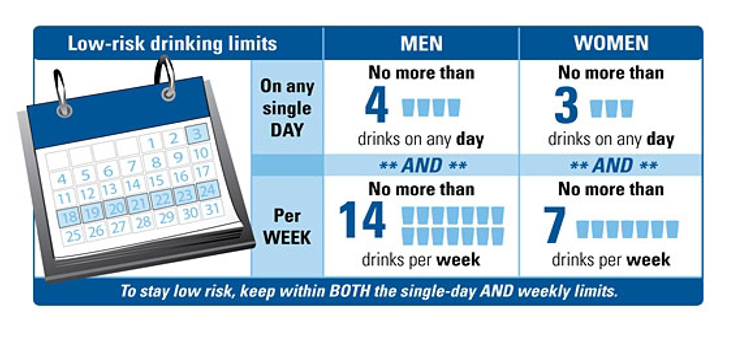Mental Health: Low Risk Drinking Guidelines
A glass of wine or beer is a relaxing way to end the day, but in these times of COVID-19 stress, is it possible to drink a little too much?
Today, we will provide you with a review of drinking guidelines from the National Institute of Health (NIH), and how these guidelines apply to you – even during a pandemic.
What is considered a standard alcoholic drink?
In the United States, a standard drink is considered 0.6 fluid ounces or 14 grams of pure alcohol. Now, what does that look like? If you look at this table we might have a better idea of what these measurements look like in real life. So this includes 12 fluid ounces of regular beer, which equals eight to nine fluid ounces of malt liquor, five fluid ounces of table wine, three to four ounces of fortified wine, two to three ounces of cordial liqueur or aperitif, 1.5 ounces of Brandy, and 1.5 ounces of 80 proof spirits, or hard liquor.

Low-risk Drinking Limits and Guidelines
Although each of these drinks is a different size they actually contain the same amount of alcohol that makes up a single drink. Now let’s take a look at the low-risk drinking limits and guidelines from the National Institute of Health. The following chart shows us that low-risk drinking limits mean for men on any single day no more than four drinks per day and no more than 14 drinks per week. Whereas for women it’s no more than three drinks on any day and no more than seven drinks per week. It’s important that when we are adhering to this low-risk limit we are keeping within both the single-day and weekly limits for standard drinking.

You’ll notice that women’s limits are less than men and that on the whole tends to be because women weigh less statistically and have less water dispersed throughout their bodies, which makes the alcoholic concentration higher when we drink, which causes more problems. Even within these limits, it’s important to know the alcohol use can still cause problems, especially if you are drinking too quickly, if you have any other health problems, or if you are over the age of 65. In fact, if you are over the age of 65 the National Institute of Health recommends that you drink no more than three standard drinks per day and no more than seven drinks per week regardless of gender.
So with this in mind and taking into account how alcohol affects you personally you may need to drink even less than the standard drinking limit suggests or even not at all. In fact, we recommend that people do not drink at all if you are under age if you are operating machinery or vehicles if you have any health problems or medical conditions that alcohol can make worse, if you have any medications that counteract with alcohol, or if you’re pregnant, or at risk, or trying become pregnant.
If you have concerns about alcohol or substance use, there is no substitute for an in-person assessment by a
reputable, qualified addictions counselor at Home Base. To learn more about our substance use recovery services for Veterans, Service Members, and their Families, visit homebase.org/connect2care or call our clinic at 617-724-5202.
 About the Author: Olivia Montgomery, LICSW is a clinical social worker at Home Base. Prior to Home Base, Olivia worked as a psychiatric social worker and intern-supervisor at Brigham & Women’s Faulkner Hospital in the psychiatric partial hospital program. She also has experience via clinical internships in primary care social work and long-term psychodynamic psychotherapy. Prior to her social work career, Olivia worked as a marine biologist and lived in Hokkaido, Japan. There, she began working in suicide prevention, which she continued upon return to the United States. In addition to suicidology, Olivia’s graduate research also includes inter-generational and systemic trauma, specifically working with former child soldiers in Kampala, Uganda.
About the Author: Olivia Montgomery, LICSW is a clinical social worker at Home Base. Prior to Home Base, Olivia worked as a psychiatric social worker and intern-supervisor at Brigham & Women’s Faulkner Hospital in the psychiatric partial hospital program. She also has experience via clinical internships in primary care social work and long-term psychodynamic psychotherapy. Prior to her social work career, Olivia worked as a marine biologist and lived in Hokkaido, Japan. There, she began working in suicide prevention, which she continued upon return to the United States. In addition to suicidology, Olivia’s graduate research also includes inter-generational and systemic trauma, specifically working with former child soldiers in Kampala, Uganda.


 Home Base
Home Base